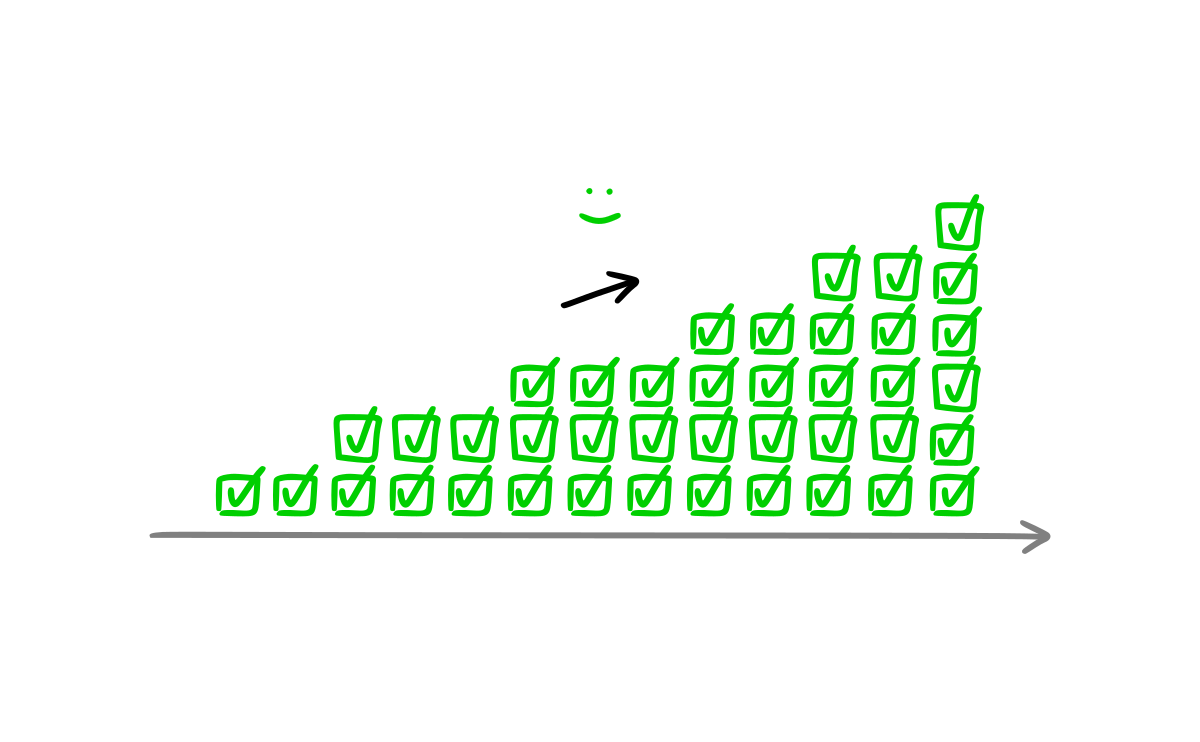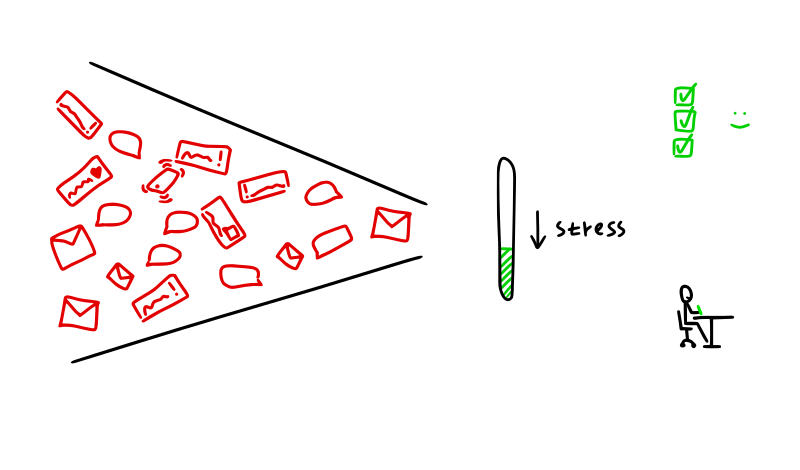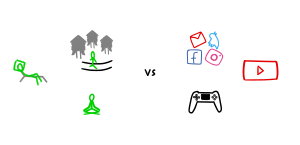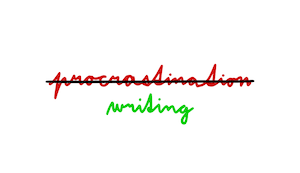How to change yourself

Do you feel like you don’t have the motivation to do things?
People often think they need motivation to achieve something. They also might think lacking motivation is a personal flaw and means they’re lazy. However, motivation is fleeting and trying to rely solely on motivation is a losing proposition.
In reality, when people speak about motivation, they really mean adherence. Adherence is sticking to a plan, despite the ups and downs of life. Motivation is just a part of adherence.
Adherence is the most important piece of the puzzle for achieving long-term goals because sticking with behaviors is the best predictor of success. Do you want to learn a new language? Practice it every day to learn! Do you want to write a book? Write every day. Do you want to lose weight? Stick with your diet every day.
There are 6 stages to adherence[1]:
- Inspiration
- Motivation
- Intention
- Discipline
- Habit
- Passion
Understanding these 6 stages and how to apply them together will help you achieve long term goals more easily. However, most of the information out there tells us something different.
Why most advice out there is wrong
Most internet articles, self-help gurus, Youtube videos, and books yell at us to focus on one step only:
FOCUS ON BUILDING HABITS!
BUILD YOUR WILLPOWER!
SET GOALS!
YOU HAVE TO FIND YOUR PASSION!
However, people are complex and trying to fix them by giving them one trick often doesn’t work. When someone tells you to focus on a single step as a solution to all your problems, take it with a grain of salt.
Advice like ‘find your passion’ leads to the thought that this will solve everything for you. Not only is it unhelpful, but it can also be downright depressing. Great, I don’t have a passion. What now? To find out what your passion is, you have to explore a lot, try things, and get good at them. A passion won’t suddenly appear out of the blue.
As we’ve written about here, depressed or chronic procrastinators have to first get excited (Inspiration) and get moving to establish some positive feedback loops (to get some Motivation). For them, looking for a passion is a terrible mistake because even if they found something, they wouldn’t be able to act on it.
To successfully achieve change, we have to combine at least 4 stages of the adherence process. Let’s get through them.
Hi there! This is a free sample chapter from our book.
If you want to get a whole comprehensive guide about procrastination and learn about each fear deeply, check out our handbook.
We put hundreds of hours of research into it, so you don’t have to. And also we keep updating it often to give you the best, most concrete strategies for dealing with procrastination.
1. Inspiration
This is the spark that starts a change. For example, you decide to finally stop procrastinating because you hate the feeling of not having done anything productive at the end of the day.
When you get inspired, excitement is ignited within you. It can even make you feel like you have the power to conquer the world.
Inspiration is the first step to achieving change and without it, it’s difficult to begin long-term change. It is possible to change without inspiration but it’s more difficult.
Inspiration can be derived from both good or bad experiences. You can read, see or watch something inspiring that sparks your excitement.
In the realm of productivity, however, it’s mostly drawn from negative experiences like delaying work, procrastinating the whole day, playing video games, or escaping real life. You get disgusted with yourself and that leads you to change.
The biggest problem with inspiration is that it doesn’t last, meaning you can’t rely on it. You can get inspired in the evening but it can be gone by the next morning. The stronger the experience is, the longer the inspiration can last, but it will go away nonetheless.
The most we can do with inspiration is transform it into strong motivation. For example, when you’re angry with yourself, you can write down all your thoughts. Then, take what you wrote and put it somewhere you will see it every day. This works as a strong motivator because it serves as a reminder to avoid this state again.
2. Motivation
Motivation is the inner desire to do something and is needed to achieve things. If you lack the motivation to do something, you probably won’t do it.
The reason why we can’t rely solely on motivation is because it is also fleeting. One day, we have enough motivation and doing the tasks we want to isn’t a problem. Another day, we don’t have the motivation, it simply isn’t there. When this happens, you need to use discipline (4th step of adherence).
However, motivation should carry you a long way so here’s how to increase it:
Remind yourself of the why
Oftentimes you don’t feel motivated because you forgot why you wanted to do something in the first place. When you remind yourself of the reason, it can help you dramatically regain motivation. Of course, the more important the reasons are, the more motivated you will be.
Your motivation will be different if you procrastinated something important and it caused a lot of pain in your life than when you simply procrastinated doing laundry.
People often use painful memories as a reminder of the reasons why they want to do something.
Start the motivation cycle
The great thing about motivation is that it can be self-reinforcing. The more motivated you are, the more progress you achieve, which in turn motivates you even further. This positive feedback loop can help you gain momentum.
This is why you want to set goals (more about that in 3rd step - Intention). Once you reach the goals, learning to enjoy the wins is helpful. After a while, you will start to associate the work with the wins and won’t make excuses to avoid it anymore.
We also get motivated when we overcome temptations. Say you wanted to stop working and procrastinate, but instead you pushed through and got some more work done. That feels great and motivates us to keep going the next time.
Decrease the difficulty
If you set unrealistic goals, it will only frustrate you. Most of us can’t change our lives by turning 180 degrees immediately. This is only viable in extremely motivating situations. For example, a life-threatening disease forces you to change your lifestyle habits or the closeness to death stops you from wasting time altogether.
These situations can’t be created artificially and therefore we can’t count on them. If you’re not working at all, you can’t jump to working 12 hours per day and expect it to be sustainable.
The more difficult a task is to do, the more motivation you will need to do it. If you’re constantly feeling that a task is too difficult and requires excessive discipline, you may have to lower the difficulty.
Be around positive people
Motivation is connected to our belief that we can achieve something.
When you’re around people who support you or even better successfully achieve what you’re trying to do, it can be motivating. Seeing other people succeed makes you think you can as well.
There is also an element of peer pressure involved here, since you don’t want to fail in front of others.
You can have all the motivation in the world but without knowing what to do exactly, it will go to waste. This is where intention comes in handy.
3. Intention
Intention is a commitment to execute a plan. It means that you set goals and then decide how to get there.
This is where many people fail because they set goals but don’t really decide on a roadmap. Without a roadmap, goals are just dreams.
Let’s say you want to be more productive. But what does “more productive” mean exactly?
You set a goal of finishing your thesis. The thesis has to be 15,000 words long. What’s the roadmap for that? You set an intention to write every weekday from 8 to 10AM. Now you know exactly when you’re supposed to focus.
However, that’s only one step. Intentions, roadmaps, and goals are nothing without action.
Sometimes, you will have enough motivation to execute your roadmap, but when the motivation isn’t there you need to use discipline.
4. Discipline
Discipline is when you use willpower to complete a task you intended to do when you don’t have motivation. Sometimes, you just won’t feel like doing it and that’s when discipline is necessary.
That being said, you want to minimize the usage of discipline as much as possible. If you’re constantly having to use discipline, maybe your intention isn’t in the realm of your abilities and you should set more realistic goals (as referenced earlier under Motivation).
There are two things to consider. First, you can’t use discipline all the time. If you overuse it, you run yourself into the ground. You burnout and stop caring about anything. Conversely, the more you use discipline, the easier it is to exert the next time.
Science has been having a strong ongoing discussion about whether willpower is depletable and whether it can be trained. Recent studies suggest that willpower is a finite resource if you believe it is a finite resource. With that logic, it appears willpower is what you believe it is.
From an anecdotal perspective, discipline is trainable in the sense that you’re making it into a habit. If you reject a donut, it’s easier to reject one the next day because you’ve done it before. However it’s more difficult to reject the next donut if you’re asked again in 5 minutes because your willpower has been used.
The good news is if you stick with a behavior long enough by using either motivation or discipline, it will slowly develop into a habit.
5. Habit
After you start something and your initial enthusiasm runs out, you might start thinking about how difficult it is. You don’t know how someone can write and publish regularly, work the whole day, or stick to a healthy diet all the time.
But there are people who do this nearly effortlessly. They don’t have to think about it twice because they’re used to it.
And this is something that should fuel our motivation to keep going. Anything will get easier after 3-4 weeks of doing it because it will start becoming a habit.
A habit is something you do automatically, without almost any need for discipline or motivation.
However, there is something to consider: we live in the age of habits. Everyone is talking about them and books are published on the same topic over and over again.
While habits are great, establishing them can be complicated.
One common piece of advice is to start by making habits ridiculously small. Do 1 push-up, write 1 sentence, take 3 deep breaths. This is useful, especially if you don’t feel motivated. Yet, there is a trade-off between tiny habits and real habits.
The tiny habits method tells you to do something ridiculously small to start a habit and keep it alive. The issue is that tiny habits can also result in tiny progress, which may or may not be meaningful to you.
If you think that you can do it, start with a meaningfully sized habit. For example, meditate for 5-10 minutes every day. When you meditate for a couple minutes instead of taking just 3 deep breaths, you’ll probably feel much calmer. That positive change in your mental state will establish a positive feedback loop.
However, if you can’t bring yourself to meditate for 10 minutes, then the tiny approach of taking 3 breaths is for you.
The last (and optional) stage of adherence is passion. If you keep doing something, you might become passionate about it.
6. Passion
Having passion means loving what you do. When you’re passionate about something, it is super simple to adhere to your plan. Why wouldn’t you do something that brings you so much joy?
The bad news is you can’t exactly choose what you like and don’t like. It’s the same with people. You can’t start loving someone because you repeat it to yourself. You can maybe help it (we will show how below), but you can’t choose it.
You have a unique personality that predisposes you to like something. There are people who love accounting, maybe because they have a predisposition to like order and making sense of numbers.
The good news is you don’t need passion to achieve success.
How to increase chances of developing a passion:
Develop a skill
Once you get good at something, it’s much more likely that you’ll enjoy doing it. We enjoy mastery. This is why passion can’t be found easily. Often, people start loving things only after they become good at them.
Nourish your curiosity
We’re curious and want to explore and understand everything. But sometimes this curiosity is killed by being forced to learn things you don’t care about, or by escaping the real world through playing games, social media, or abusing substances. Learn to get bored to be more curious.
Do it with people you like
We’re also social creatures and want to do things with other people. This is why many people fall in love with martial arts or collective sports. There is a sense of companionship and camaraderie that makes the activity more enjoyable.
Summary
Here are the 6 stages of adherence again:
Inspiration
You feel inspired. You want to act. Inspiration is fleeting.Motivation
You take action only when motivated. You don't have a definite plan.Intention
You set realistic goals and figure out a roadmap to get there. You take action, get early wins, transform the wins into more motivation.Discipline
You practice using discipline even if you don't have motivation. You show up.Habit
You keep showing up, and after 3-4 weeks, it's much easier (sometimes even effortless.)Passion
You're lucky and start enjoying the process a lot. You get passionate about it. Making progress fun and almost inevitable.
You can apply this for training, writing, posting on social media, or anything else.
Now that you understand this process, see where you are in your own life and where you want to go.
1Props to Dr. Mike Israetel for pointing this model out.


